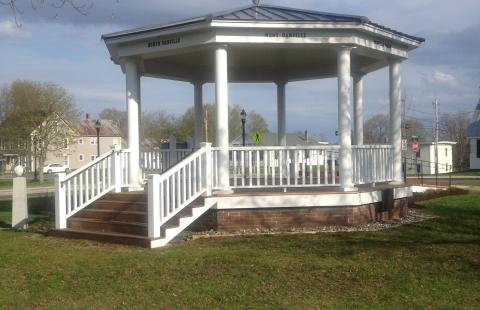What were the specific goals of this creative economy project? Describe the community development challenge or opportunity that your project was designed to address:
The Route 2 project through Danville had been stalled for over a decade prior to the involvement of the Arts Council for a variety of reasons, including community concerns about the incursion of an expanded federal highway on the village center of Danville. The primary goals of this collaborative project were to upgrade road conditions through the Village, and to provide better sightlines and improved vehicular and pedestrian safety while respecting the aesthetic and cultural fabric of the community.
This project sought to the essential rural character of Danville and keeping its village center intact, while meeting the essential need for an important state transportation corridor. It was hoped that Arts Council involvement could engage the community in the redesign of this federal highway and help to minimize the impact of Route 2 on the village center of Danville.
If the goals change over time, please describe how:
Throughout the process, the focus was on developing roadway designs that would enhance the essence of a small, close-knit, rural community by providing a safe, attractive, and comfortable pedestrian environment in the Village of Danville and celebrate its unique historic, built, and natural features. The partners did not waiver from their commitment to these goals and did not change over time.
Who was involved in this project and what did they do? (be sure to include the partners from outside of the creative sector and how local voices were included):
Vermont Agency of Transportation (VTrans): Coordinated the overall transportation project, managed the federal and state transportation funds, coordinated all construction and permitting processes.
Vermont Arts Council (Council): Coordinated artist selection process, contracted with the artists, oversaw the design, fabrication, and installation process in collaboration with VTRans and the Danville Select Board and the Local Review Committee. Coordinated meetings of the Local Review Committee and acted as liaison with the artists.
Danville Select Board: The local governing body in the Town that oversees calling town meetings, proposing budgets, coordinating, making Town decisions about design, and construction projects.
Local Review Committee: Oversaw the Project from conceptual design through maintenance, including installation and was made up of representatives from the Town Select Board, Library, School, Planning Commission, Village Improvement Association, Historical Society, Chamber of Commerce, Local businesses, residents, Vtrans project managers and Vtrans engineering Consultants and coordinated by the Vermont Arts Council
Artists: Vermont artists David Raphael, landscape architect from Landworks in Middlebury, VT and Andrea Wasserman, sculptor from Vershire VT were selected by the Local Review Committee and brought into the design process.
How does this project relate to a larger community development strategy?
The project addressed the principles of “Context Sensitive Design” which are defined by the Federal Highway Administration as “a collaborative, interdisciplinary, approach that involves all stakeholders in developing a transportation facility that complements its physical setting and preserves scenic, aesthetic, and historic and environmental resources while maintaining safety and mobility.”
The Village Green in Danville was an important focus of the artistic enhancement efforts to create a vibrant community. The Green is now listed with the Vermont Village Green Initiative being undertaken by the Vermont Agency of Commerce and Community Development. The initiative will document, analyze and promote the cultural, economic and environmental benefits of village greens in Vermont. Understanding this context is paramount in preserving and revitalizing our historic village greens. Through research, documentation and observation this exploration will shed light on the cultural and environmental significance of village greens in Vermont. This initiative will be shared, marketed and promoted to increase exposure of our cherished village greens and offer insight into the meaning of village greens in the settlement and ongoing development of Vermont villages.
Vermont’s village greens lie at the physical and cultural heart of communities. Located historically where roads converged, where meetinghouses were established, where commerce concentrated and homes clustered, village greens hold a special place in community life. Greens are open spaces around which community life has grown. In contrast to the buildings and streets around them, they represent a positive void. The historic, civic, spiritual, and economic life of the community is often represented in the buildings around the green. But the significance of the green goes beyond its physical location and appearance—it has cultural value as well. It is a gathering place, a place for the community to observe tradition and celebrate holidays. Village greens are the site of concerts and fairs, commemorations and parades, seasonal festivals and farmers markets.
The green is part of a larger ensemble of townscape elements that provide us with a sense of time and place. It is often the only public space that reflects the collective interests, desires, and values of a community. This has long been the role of the green, and is no less true today.
What projects or places, if any, inspired your approach to this creative economy project?
The Vermont Arts Council was influenced by the public art movement across the nation and the work of the Animating Democracy program through Americans for the Arts. Initially, the Council was inspired by the work done by Vermont artist Michael Singer. One of Singer’s most influential infrastructure projects is the 27th Avenue Phoenix Waste Transfer and Recycling Center; created with artist Linnea Glatt. The artist-led design team reimagined the entire facility as an aesthetically and environmentally advanced civic asset. The New York Times chose the design as one of the top eight design events of its year, noting its “ambitious program that joins art to infrastructure”.
